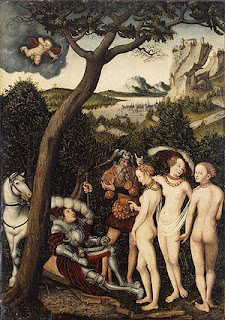
This concludes the First Season of Dee Dee & Salvador Dali's exploration of Tarot Universal Dali based upon a card selected each week -- so far randomly. Next posting will open the Sign of Aries, the start of the Zodiac year.
This initial Winter Season opened in the waning Cusp of Capricorn with the callow Knight of Pentacles pursuing
 wealth. In the Sign of Aquarius -- first the Eight of Wands then the Two of Cups -- he struggles with the definitions of Victory and against Restraints.
wealth. In the Sign of Aquarius -- first the Eight of Wands then the Two of Cups -- he struggles with the definitions of Victory and against Restraints.
Still in the Sign of Aquarius appears La Luna -- The Moon -- the power of the subconscious. It feels good slipping out of definitions an restraints into what lurks beneath.


As the Cusp of Pisces approaches Diane the Huntress on the Seven of Swords appears. Winter deepens, but still it seems a genuine victory to see such confidence arrive.
Short lived.

Opening Day of the Sign of Pisces. La Torre. Total destruction. The Go-Back-to-Start of the traditional Tarot symbolism. This is one of The Tower's messages: You Can't Have It All. This is the card that tells of false Idols. Of false Gods. This is the card where the you that is you is lost. Lost and gone forever. This is the card that makes us clutch at life in the face of absolute destruction. This is the card that demands Rebirth. This is the Phoenix.
Nicely followed with the gentle Sota de Bastos
 -- Batons yes, Wands more traditionally, but regardless they are wood and thus combustible -- Wands resentative Fire. Ignition. Yet the ignition brings next week the frightening Six of Swords with its promise -- soon to be broken -- of fair skies ahead.
-- Batons yes, Wands more traditionally, but regardless they are wood and thus combustible -- Wands resentative Fire. Ignition. Yet the ignition brings next week the frightening Six of Swords with its promise -- soon to be broken -- of fair skies ahead.
Indeed. Days later Tarot Universal Dali's Seven of Coins arrives with Caravaggio's Mary Magdalen. The painting is of The Virgin who has died -- in contradiction to a recently changed church policy -- on Earth.
By now unusual
 coincidences are showing up in unusual places as this endeavor evolves. On the day Siete de Oro posts, the long-lost remains of Caravaggio are returned upon the 400th anniversary of his disappearance.
coincidences are showing up in unusual places as this endeavor evolves. On the day Siete de Oro posts, the long-lost remains of Caravaggio are returned upon the 400th anniversary of his disappearance.Only one card is left to draw in this First Winter of this Endeavor of Dee Dee & Salvador Dali. Pisces swims upstream as the selected card is turned: The World. The final card of the Major Arcana.
Auspicious.
 Even propitious in a traditional Tarot deck or in a classic read.
Even propitious in a traditional Tarot deck or in a classic read.But all is always askew in Tarot Universal Dali. It is an important lesson The Magician offers. In this time when so very much is askew.
Comment: Might we come out of this winter and make askew The World's sad tradition? Might we use The Magician's optical opportunities to see the tears of blood locked out and retreating? Might we be able to focus on the tiny remains of innocence in Tarot Universal Dali's El Mundo? They are, after all, in the forefront.
















